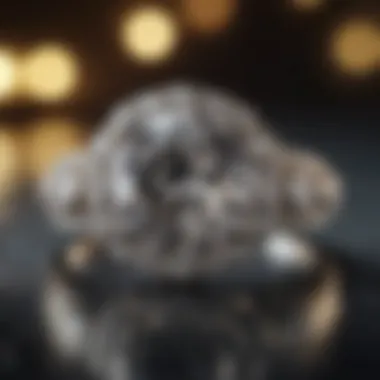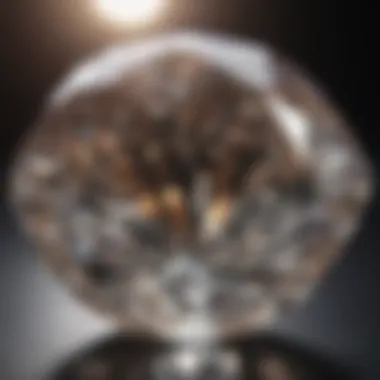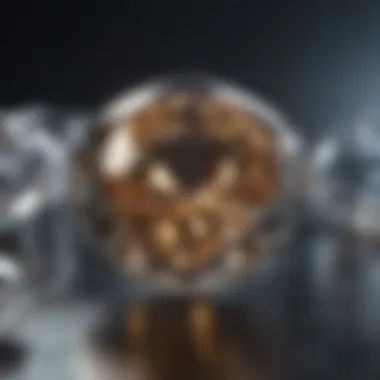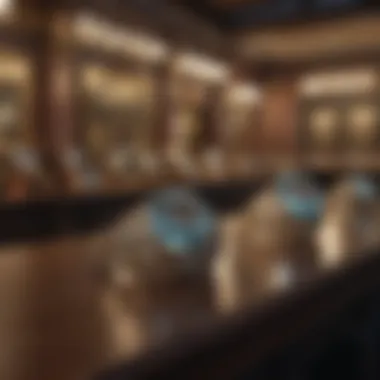Understanding Diamond Jewellery Auctions: A Comprehensive Guide


Intro
The diamond jewellery auction process is a fascinating intersection of art, science, and commerce. In understanding these auctions, both buyers and sellers uncover not just the tangible value of the diamonds but also the intricate dynamics that govern the market. A nuanced grasp of this world is essential, as many factors contribute to valuations and bidding processes.
This section sets the stage for a thorough exploration of diamond auctions. We will examine the various elements at play, from the nature of the gemstones themselves to the evolving ethical considerations surrounding their sourcing. Additionally, the growing prevalence of online auction platforms will be discussed, as these platforms are reshaping traditional auction practices.
As we delve deeper into these topics, we aim to provide not only a comprehensive understanding but also insights that will enrich participants' experience during diamond auctions.
Preamble to Diamond Jewellery Auctions
Diamond jewellery auctions represent a convergence of art, value, and commerce, serving as a platform where unique pieces can be acquired by discerning buyers. The importance of understanding this topic cannot be overstated, as it encompasses not only the operational mechanics of these auctions but also the broader implications for those involved in the trading of luxury items.
For collectors and enthusiasts alike, diamond auctions are more than mere transactions; they are opportunities to gain insight into quality, rarity, and authenticity. Each diamond tells a story, influenced by its origin and journey before reaching the auction block. As such, comprehending the intricacies of these auctions can significantly enhance a participant's experience, ensuring informed decisions are made.
In addition, the digital transformation has led to an expansion of auction formats, with online platforms growing in popularity. These advancements necessitate a closer examination of how auctions operate, particularly in terms of accessibility and transparency. Collectors must learn to navigate this evolving landscape, weighing the benefits and drawbacks of engaging in either online or traditional auction settings.
Furthermore, the auction process often involves various stakeholders, including auction houses, buyers, and sellers. Understanding the motivations and strategies of each party can provide an edge in bidding. Whether one is new to diamond collecting or seeking to refine a seasoned portfolio, knowledge of the auction framework is invaluable.
The benefits of participating in diamond jewellery auctions extend beyond mere acquisition. They serve as educational opportunities for buyers and sellers, providing insights into market demand and valuation factors. The topic of diamond auctions is thus deeply relevant for anyone interested in gemstones, whether for personal collection, investment, or professional engagement.
"Informed engagement in diamond jewellery auctions can transform potential risks into rewarding opportunities."
This section aims to set the foundation for a comprehensive understanding of diamond jewellery auctions, thus laying the groundwork for deeper exploration in subsequent sections.
Historical Context of Diamond Auctions
Understanding the historical context of diamond auctions reveals much about their significance in the luxury market. Diamond auctions are not merely venues for buying and selling; they are stages where history, wealth, and culture intersect. Knowing the evolution and the prominent players in this arena allows both buyers and sellers to navigate the complexities involved effectively.
The Evolution of Auctions
The auction system dates back thousands of years. Initially, goods were exchanged in informal gatherings. By the 18th century, auctions became more structured, especially in Europe. Diamonds, being valuable commodities, found their way into these auction houses. Over time, auctions have adapted to reflect societal changes and economic trends.
In the mid-20th century, diamond auctions began to take on a new significance. The introduction of grading systems provided the framework to assess diamond quality. The rise of luxury markets has further propelled diamond auctions into the spotlight, marking a shift from private sales to public bidding events. This evolution highlights how diamond auctions have become platforms where not just products are sold, but also brand prestige and investment opportunities.
Influential Auction Houses
Several auction houses have shaped the diamond auction landscape. Notable ones include Christie’s and Sotheby’s. These houses have a long history and have curated significant diamond sales that often set market trends. They possess an established reputation that lends confidence to buyers and sellers alike.
Christie’s, founded in 1766, has conducted numerous high-profile auction events. The ‘The Red Emperor’ diamond set a record at a Christie’s auction in Hong Kong. Similarly, Sotheby’s has been influential in promoting rare diamonds that attract collectors from around the world, creating a competitive atmosphere.
"Auction houses have a dual role: they authenticate and promote valuable diamonds, while also acting as a mediator between seller and buyer."
These houses provide a critical service in ensuring that diamonds sold at auction are genuine and of high quality. Their expertise helps in establishing trends regarding what types of diamonds will attract buyer interest. This understanding of auction houses is crucial for anyone considering participation in the diamond auction market.
Understanding the Auction Process
The auction process is a crucial component of diamond jewellery trading. It serves as the platform where sellers present their diamonds, and buyers place their bids, hoping to acquire valuable pieces. Understanding this process enhances the experience for all participants as it reveals the dynamics of value determination, buyer engagement, and seller strategy. Here, we will explore the pre-auction preparations, effective bidding strategies, and essential post-auction procedures that shape this unique marketplace.
Pre-Auction Preparations
Preparation before an auction is crucial for both buyers and sellers. For sellers, this involves ensuring the diamonds are presented in the best light possible. This can include professional cleaning, evaluating the diamond's certification, and deciding whether an appraisal is necessary. Sellers should also familiarize themselves with the auction house's rules and fees to set realistic expectations regarding final sale prices.
Buyers, on the other hand, should take a systematic approach at this stage. Learning about the auction house and its reputation can help determine how much trust to place in the diamonds offered there. Moreover, interested buyers should prepare by researching specific diamonds they want to bid on. Understanding the Four Cs—carat, cut, clarity, and color—is essential to make informed decisions. Additionally, setting a budget ahead of the auction will help avoid impulsive bids driven by excitement.


Bidding Strategies
Bidding in a diamond auction is an art form that requires planning and awareness. A few common strategies can significantly enhance the likelihood of winning a desired diamond. Firstly, it is vital to start with a firm maximum bid and stick to it to avoid emotional spending, which can cloud judgment.
Moreover, watching the auction's initial bids can provide useful insights. If a diamond attracts immediate interest, it might indicate high demand. Thus, waiting and observing can provide opportunities to see how other bidders behave. Another strategy is identifying less popular diamonds. These may provide hidden gems at lower price points.
Communication with the auction house regarding bidding methods is important as well. Some auction houses allow absentee or phone bidding for those who cannot attend in person. Understanding this can ensure participation regardless of physical presence.
Post-Auction Procedures
After the auction concludes, both buyers and sellers enter the crucial post-auction phase. For sellers, this usually involves a follow-up with the auction house and possibly arranging for payment. Monitoring after-auction results is important to gauge interest levels for future sales.
Buyers should contact the auction house as soon as possible to finalize payments and pick up their newly acquired diamonds. Confirming that the diamond is exactly as described in the auction catalogue is vital. Handling documentation and certification at this stage ensures that the buyer's investment is protected.
Effective post-auction practices can solidify the experience, allowing all parties to leave the event satisfied.
"Understanding the auction process ultimately empowers buyers and sellers to navigate the market with confidence."
By grasping the nuances of the auction process, potential participants can enhance their experience, whether they are bidding or selling. This deeper comprehension provides clarity, benefiting everyone involved in the diamond jewellery auction landscape.
Factors Influencing Diamond Value
Understanding the factors that influence the value of diamonds is crucial for anyone involved in diamond jewellery auctions. Several key elements contribute to determining a diamond’s price, and a deep comprehension of these can significantly affect both buyers and sellers in the auctioning process.
The Four Cs of Diamonds
The Four Cs—Carat, Cut, Color, and Clarity—are fundamental in assessing a diamond's quality and, thus, its value.
- Carat refers to the weight of the diamond. Generally, larger diamonds are rarer and more valuable.
- Cut involves how well the diamond has been shaped and faceted. A well-cut diamond reflects light beautifully, adding to its allure.
- Color describes the presence of color in a diamond, with completely colorless diamonds fetching higher prices.
- Clarity indicates the presence of imperfections. Diamonds with fewer inclusions or blemishes are more sought after.
As such, these Four Cs provide a standardized way to gauge diamonds, making them critical for valuation in both live and online auctions.
Market Trends and Demand
Market trends play a significant role in diamond valuation. Public interest, fashion trends, and economic conditions influence demand in the auction market.
Factors that can affect these trends include:
- Seasonal trends, like holidays and wedding seasons.
- The rise of lab-grown diamonds may impact traditional diamond demand.
- Popularity in social media can affect aesthetic preferences.
It’s essential for both buyers and sellers to stay informed on these market dynamics to make informed decisions during auctions. Understanding how trends shift can be the difference between a profitable sale and a missed opportunity.
Provenance and Certification
The provenance of a diamond signifies its history and origin, while certification is the formal verification from authoritative organizations such as the Gemological Institute of America (GIA).
- Provenance assures buyers about the ethical sourcing of diamonds and transparency concerning their origin. This factor is especially critical given the rise of ethical consumerism.
- Certification provides a detailed account of a diamond's characteristics. A certified diamond is more likely to command a higher price in auctions as it guarantees specific quality metrics.
Provenance and certification are increasingly important in today’s market. They contribute to a diamond's desirability and add layers of value by aligning with ethical considerations and buyer trust.
"Understanding the factors influencing diamond value not only helps in making informed purchasing decisions, but also in strategizing sales effectively in the competitive auction environment."
Buyer Considerations in Auctions
Understanding the buyer's perspective in diamond jewellery auctions is crucial for successful participation. This section will explore the significant elements that potential buyers must consider before entering the auction arena. Physical appraisals, research, and awareness of market conditions are not just beneficial; they are essential for making informed decisions.


Evaluating Diamonds Before Bidding
Before making a bid in an auction setting, buyers must conduct thorough evaluations of the diamonds on offer. Physical inspection is often the first step. This involves examining the diamond's overall quality, cut, and clarity. Buyers should look for any visible inclusions or blemishes.
The journey does not stop at the auction house. Buyers should also seek certification reports from reputable institutions like the Gemological Institute of America or International Gemological Institute. Such documents provide essential details like the Four Cs — carat weight, cut, color, and clarity — that directly impact value. Understanding these components empowers buyers to gauge whether the estimated price aligns with the diamond's true worth.
Another aspect to consider is the provenance of the diamond. Knowing its history and prior ownership can significantly influence a buyer's perception and valuation. Buyers should scrutinize the auction catalog and, if possible, seek additional information from the auction house regarding the diamond's journey.
Understanding Auction Fees
Every auction has fees that buyers must take into account, as these often influence the final cost of acquisition. Auction houses typically charge a buyer's premium, which is a percentage added to the winning bid. For example, if the hammer price is $10,000, and the buyer's premium is 15%, the total amount payable would be $11,500. Buyers must be aware of such fees upfront to avoid unpleasant surprises.
Other potential costs include shipping fees, insurance, and possible import taxes depending on the buyer's location. Familiarizing oneself with the terms and conditions outlined by the auction house is vital. These conditions often detail fees and other add-ons that can contribute to the overall expenses, impacting the buyer's budget and strategy.
To navigate the auction landscape effectively, buyers need to arm themselves with knowledge. A well-informed buyer is more likely to make advantageous decisions.
In summary, careful evaluation of diamonds and comprehension of auction fees are indispensable for any buyer aiming to participate in diamond auctions. Knowledge and preparation set successful bidders apart from the rest.
Seller’s Perspective on Auctions
The perspective of sellers in diamond jewellery auctions is crucial. Understanding their viewpoint enhances the overall comprehension of the auction dynamics. Sellers often aim to maximize the financial returns from their diamonds while also ensuring a smooth auction process. Knowing the challenges and benefits experienced by sellers adds depth to the auction environment.
To successfully navigate an auction, sellers must consider the right preparation and marketing strategies. This enables them to showcase their diamonds in the best light, increasing perceived value. Sellers should be aware of market demand and trends. This knowledge directly influences the timing of their auction participation.
Preparing Diamonds for Sale
Preparing diamonds for sale is a fundamental step in the auction process. Sellers must present their gemstones in optimal condition. This preparation involves several critical elements:
- Stone Evaluation: It is essential to evaluate the diamond based on the Four Cs: Carat weight, Cut, Color, and Clarity. A thorough assessment informs both the seller and potential buyers of the diamond's value.
- Professional Grading: Obtaining a certificate from a recognized gemological laboratory adds credibility. Certificates from institutions like the Gemological Institute of America (GIA) or the International Gemological Institute (IGI) can enhance buyer confidence.
- Photography and Presentation: High-quality images play a vital role in attracting bidders. Professional photography that highlights the diamond’s best features can significantly increase interest.
- Reserve Pricing: Setting a reserve price is a cautious approach. It protects the seller by ensuring that the diamond will not sell for less than a predetermined amount.
Marketing Strategies in Auctions
Marketing strategies are crucial for sellers participating in auctions. An effective approach can differentiate a diamond from numerous others on the market. Here are some key tactics to consider:
- Leveraging Auction House Reputation: Sellers should choose reputable auction houses with a history of successfully selling diamonds. The credibility of the auction house can enhance interest in the stones being sold.
- Targeted Advertising: Utilizing social media platforms like Facebook can help reach out to potential buyers. Building an online presence strengthens visibility and attracts a selective audience.
- Engaging Descriptions: Descriptive narratives that convey the uniqueness of each diamond are vital. Sellers should craft compelling descriptions that focus on the emotions and stories attached to the diamond.
- Participation in Pre-Auction Events: Attending pre-auction exhibitions enables sellers to engage potential buyers directly. This personal interaction can foster relationships that lead to bidding confidence.
"Understanding the seller's perspective can significantly impact the strategies employed to maximize auction success."
Taking these steps ensures that sellers are not just participants but active strategists in the diamond auction arena.
Online Auctions vs. Traditional Auctions
The Rise of Online Platforms
In recent years, the emergence of online platforms has revolutionized the diamond auction landscape. Offering convenience, accessibility, and a global reach, websites like Sotheby’s and Christie’s have adapted their auction models to cater to a tech-savvy clientele. Online auctions allow participants to conduct transactions from anywhere with internet access.
This format appeals especially to younger generations and international buyers who may not have the means to attend traditional auction events in person. Additionally, many platforms provide detailed listings with high-resolution images and descriptions. This fosters a more informed buying experience, where bidders can evaluate gems thoroughly before placing bids. Potential buyers can also capitalize on the wider availability of diamonds from various regions, which broadens their options significantly.
Advantages and Disadvantages
Understanding the pros and cons of both auction styles is paramount. Traditional auctions, often held in prestigious locations, offer a tactile experience. Participants can view the diamonds firsthand, benefiting from expert evaluations during previews. Furthermore, auctioneers can enhance the atmosphere, creating a sense of urgency and excitement that might not be present in online environments.
However, traditional auctions also come with notable downsides. They often involve higher fees due to operational costs, and potential buyers must work around scheduled events, which could limit their bidding opportunities.


In contrast, online auctions present flexibility and lower fees in many cases. They allow bidders to participate from anywhere in the world at any time. However, there may be concerns regarding the authenticity and grading of diamonds, as buyers rely solely on images and descriptions. Moreover, the lack of personal interaction could diminish the excitement associated with bidding.
Ultimately, both platforms serve distinct needs, and understanding their merits and shortcomings empowers buyers and sellers to choose the most suitable auction format for their diamond transactions.
Ethical Considerations in Diamond Auctions
Ethical considerations play a significant role in diamond auctions. The diamond industry has faced scrutiny over the years due to concerns about conflicts, human rights abuses, and environmental impacts.
Understanding these ethical implications is crucial for both buyers and sellers. Participants in diamond auctions are increasingly aware of the source of their diamonds. This awareness influences their purchasing decisions. Buyers often prefer diamonds that are certified conflict-free. Sellers, on their part, are compelled to demonstrate ethical sourcing to appeal to conscientious consumers. This shift is not only beneficial in terms of consumer preference but also promotes a more responsible industry overall.
In this section, we will examine two key aspects of ethical considerations: conflict diamonds and sustainability practices.
Conflict Diamonds and Their Impact
Conflict diamonds, also known as blood diamonds, are stones mined in war zones and sold to finance armed conflict. This issue gained global attention in the late 1990s, leading to the establishment of the Kimberley Process Certification Scheme. The process aims to ensure that diamonds are sourced from conflict-free regions.
The impact of conflict diamonds is profound. They contribute to instability in regions, often leading to human rights violations. Consumers are becoming more selective. They now ask pointed questions about the origins of diamonds before making purchases. Auction houses have begun to take action by enforcing strict guidelines to eliminate conflict diamonds from their offerings.
The following points highlight the significance of addressing conflict diamonds in auctions:
- Consumer Awareness: An increasing number of buyers wish to make informed choices.
- Auction House Policies: Many reputable houses actively promote sales of ethically sourced gemstones.
- Market Impact: The presence of conflict diamonds can devalue legitimate diamonds, affecting prices overall.
Sustainability Practices in Sourcing
With the rising demand for ethically sourced diamonds, sustainability practices have gained traction in the auction environment. This encompasses ensuring that mining operations are not only conflict-free but also environmentally responsible. Sustainable sourcing includes practices that mitigate damage to ecosystems and promote fair labor practices.
A growing number of auction houses and jewelers highlight their commitment to sustainability, showing the shift in industry standards. Here are some common sustainable practices in sourcing diamonds:
- Traceability: This allows tracking the diamond from mine to market.
- Eco-Friendly Mining: Some companies are investing in responsible mining methods that minimize environmental impact.
- Community Engagement: Supporting local communities can improve livelihoods and foster mutual benefits.
Adopting ethical and sustainable practices enhances the reputation of auction houses and reassures buyers. It underscores a commitment not only to quality but also to social responsibility.
"Sourcing diamonds responsibly is no longer an option but a necessity for maintaining integrity in the industry."
Finale
By revisiting the key elements such as the auction process, the factors that influence diamond valuations, and the ethical considerations surrounding sourcing, the conclusion provides a holistic view of the topic. It emphasizes how these auctions provide a platform not only for the exchange of valuable items but also for cultivating knowledge about the market dynamics that govern diamond jewellery.
Key Points to Consider
- Informed Decision-Making: Buyers and sellers can leverage the knowledge gained from this article to make informed decisions during auctions. Understanding the evaluation criteria can enhance the buying experience and ensure fair pricing when selling.
- Market Awareness: The conclusion stresses the need for participants to stay updated with market trends. Awareness of factors such as supply and demand can significantly impact participation outcomes.
- Ethical Engagement: It emphasizes adherence to ethical standards in diamond sourcing and transactions. Engaging in auctions with a clear understanding of sustainability issues can elevate collective industry practices.
"The significance of auctions extends beyond mere transactions; they represent a convergence of history, value, and ethical considerations."
In closing, the understanding of diamond jewellery auctions is not just for those actively involved but also for those interested in the broader landscape of gemstone investment and collection. Recognizing the intricacies of this world can lead to more enriching experiences, fostering a deeper appreciation for the art and science of diamonds.
Additional Resources and References
In the realm of diamond jewellery auctions, having access to comprehensive resources can significantly enhance one’s understanding and experience. The world of diamond auctions is intricate, replete with unique aspects that merit deeper exploration. For both buyers and sellers, familiarity with a range of resources enables informed decision-making, which is critical when navigating this complex market.
Importance of Resources
Understanding diamond auctions is not just about grasping bidding processes or recognizing valuable diamonds; it's about engaging with a tapestry of interconnected information. Additional resources serve multiple purposes:
- Knowledge Enhancement: They provide insights into the historical context and valuation processes of diamonds. This knowledge can influence strategies during auctions.
- Market Trends: Staying informed through recent publications helps participants gauge current market trends, affecting bidding behavior and expectations.
- Regulatory Framework: Resources that detail regulations and ethical considerations are essential for ensuring compliance, especially concerning conflict diamonds and sustainability practices.
Types of Resources
- Educational Websites: Platforms such as Wikipedia offer accessible articles that break down complex topics. Readers can find detailed sections regarding diamond classification, auction history, and more.
- Industry Publications: Reputable sources like Britannica provide scholarly articles and up-to-date information on diamond auctions and market dynamics, allowing readers to dive deeper into specialized knowledge.
- Online Forums: Websites like Reddit offer community insights and personal experiences with auctions. Engaging in discussions can clarify doubts and expose one to different perspectives.
- Social Media: Platforms like Facebook host groups where auction enthusiasts share tips, reviews of auction houses, and insights into current market trends.



